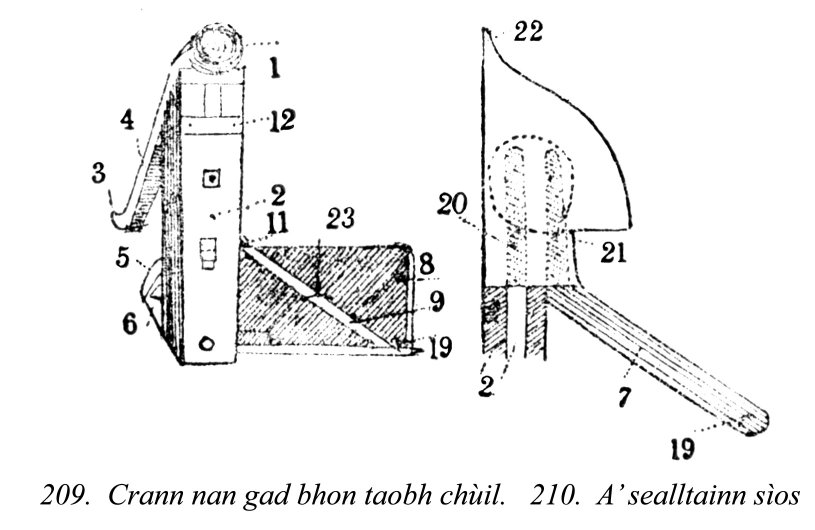crann nan gad
sm Kind of plough, seldom used now, though at one time common enough, especially in the Western Isles. The parish of Barvas is the only part of Lewis where it is still used. It is usually drawn by one horse, though two can be used. From its construction it is especially suited to the stony ground of the crofts and its gradual disappearance is a cause of great regret, as there is no other implement, equally convenient to take its place. It possesses a great advantage over the common iron plough, in that, as the point runs along the ground behind the horse, it serves the two-fold purpose of keeping the plough steady and when the share comes in contact with a stone, by lifting the handle, or làmh-chrann upwards like a lever, the share and sock can be lifted clear of the obstruction. The ploughman uses only one hand and walks on the left side of the implement, instead of behind, as is now usual in ploughing.
Parts of crann nan gad:
1 Làmh-chrann, handle.
2 Màs a' chroinn, rearpiece.
3 Sròn, point. It is shod with iron and runs along the ground behind the horse.
4 Eàrrghas, body or mainpiece, between màs and sròn.
5 Coltair, share (of iron).
6 Soc, socach, socan, sm sock (of iron).
7 Ùirthilleach, the piece of hard wood with iron sheath on it, on which the mould-board rests, held in by “maide a' chroinn-sparraidh,” by passing a thong through the mould-board and round the stick; the stick, or “maide a' chroinn-sparraidh,” being inserted in the “lùbach” of the “ùirthilleach” and pressed below “tarrag a' chroinn-sparraidh.”
8 Bòrd-ùireach, bòrd ur-chrainn, sm mould-board. — Bold (CR).
9 Maide a' chrann-sparraidh, the stick for holding mould-board in its place, by one end being fixed in a loop of iron in the “ùirthilleach” called “lùbach na h-ùirthilleach,” the other end being pressed below “tarrag a' chroinn-sparraidh” — [spàrr cruaidh e, press it hard — hence the name].
10 Tarrag a' chroinn-sparraidh.
11 Tarrag-mhaide a' chroinn-sparraidh, nail to which the bi-forked end of the stick it pressed under.
12 Na goid, bands of iron which bind the màs and eàrrghlas together. [These were originally of withes, hence their name].
13 An druim mór, long part of rope by which the plough is drawn.
14 An druim beag, short part of rope, which steadies the sròn.
15 Amall, main swingle tree.
16 Na greallagan, swingle trees next the horses to which the “sliosan” are attached by means of a “lùbach” and “cadhag” to each “slios.”
17 Na cadhagan, iron links in the form of an S, between swingle tree and plough or between two swingle trees. 2 Swingle tree wedges.
18 Na lùbaichean, loops of iron, one on each end and one in the centre of each swingle tree, in which the “cadhagan” are inserted.
19 Na sliosan, na sìntean, drag-ropes or traces, on each side of horse and attached to each end of swingle trees. — Gearraiseach (sing). — CR.
The following parts are best explained by reference to Illustrations 212 & 213:
19a Lùbach na h-ùirthilleach, the part where the lower end of “maide a' chroinn-sparraidh” is inserted.
20 Meirgeal, the stick or iron which attaches the sock and “ùirthilleach” to the “màs,” by one end being inserted in a hole through the lower end of the “màs” and the other end into “"ailean an t-suic” along with the “ùirthilleach.”
21 Ailean an t-suic, the space into which the “Meirgeal” and “ùirthilleach” are put in the sock. The illustration shows them inserted.
22 Òrdag an t-suic, toe of sock, which is inserted in a small hole in the point of the share.
Iall, thong, which passes through a couple of small holes in the mould-board, and is tied to “maide a' chroinn-sparraidh” behind, in order to keep the mould-board steady.
Na géinntean, wedges, which tighten the cotair, share and “meirgeal.”
Ciasan, iron sole, fixed on the bottom of the “màs” or rear-piece, to protect it from injury.

Ill. 210 shows the space called “ailean an t-suic,” in the underside of sock (shaded). It is drawn looking from top or upper part of sock, so that the space may be seen plainly through, it, though it would not be seen in actual fact as shown in this sketch. [We are indebted to Mr. D. Murray, Aberdeen, for many of above terms, and to Mr. M. MacDonald, Stornoway for illustrations and additional information].
Seall an duilleag thùsail / View Original Page
|
|
Chan eil mi eòlach air an fhacal seo idir / I don't know this word
0 %
|
|
|
Tuigidh mi am facal seo ach cha chleachd mi e / I know this word but don't use it
100 %
|
|
|
Tuigidh is cleachdaidh mi am facal seo / I know this word and use it
0 %
|
Chaidh a chur an cèill gu bheil am facal seo a' buntainn ris na faclan-luirg a leanas / This word has been judged relevant to the following search terms:
| sgàirneach |
| 51 |
| western isles |
| 0 |
| crann nan gad |
| 50 |
| loose |
| 50 |
| gravel |
| 50 |
|